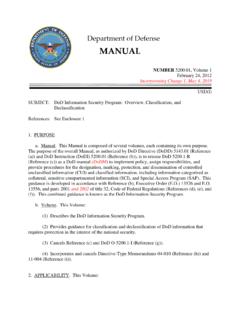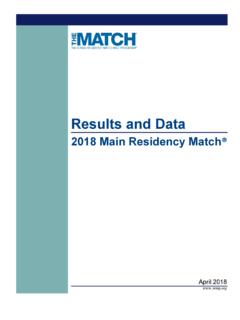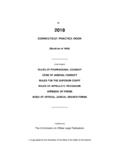Transcription of © OECD, May 2018
1 OECD, May 2018 Foreword his document describes the OECD Economic Outlook database 103rd edition - volume 2018 /1. Section 1 describes the content of the database and gives some information on how data have been compiled and how they can be accessed. Section 2 focuses on the main changes implemented in the last edition of the Economic Outlook database. Summary tables, codes and formulas have been grouped at the end of this document (annexes) to form a practical user s guide.
2 More detailed information - notably on Sources and Methods - can be found online in the OECD Economic Outlook website. The latter should be considered as an important complement to this document: T TABLE OF CONTENTS Foreword .. 3 Table of contents .. 4 1. Description of the database .. 6 The Economic Outlook publication .. 6 The Economic Outlook database .. 6 Countries and country groupings .. 6 Variables .. 6 Series codes used in the Economic Outlook statistical annex.
3 7 Frequency, annualisation and seasonal adjustment .. 7 Scale, units, currency and base year .. 7 Data processing .. 8 Sources and methods .. 9 Online sources and methods .. 9 General assessment of the macroeconomic situation .. 9 Frequently asked questions .. 9 Main sources .. 10 Identities .. 10 Where to find the data? What are the different electronic formats? .. 10 .. 10 Excel files .. 11 Export to Excel and other formats (CSV, ) .. 12 Recommended uses.
4 12 2. Main changes to the database (May 2018 ) .. 13 Date of last update .. 13 Countries and country groupings .. Variables .. Changes in methodology .. 13 National Accounts .. 13 Balance of payments .. 14 Quarterly national accounts .. 14 OECD supply-side estimates .. 14 Main changes by country .. 15 Last historical points .. 16 Country base years / Standard OECD reference year .. 16 ANNEXES Annex 1: Codes .. 18 Table Country codes .. 19 Table Variable codes.
5 21 Table Codes of variables presented in the Economic Outlook statistical annex .. 27 Annex 2: The ten economic blocks which form the EO database .. 29 Table External sectors, trade and payments .. 30 Table Government accounts .. 32 Table Expenditure and GDP .. 34 Table Selected variables ready-made growth rates .. 35 Table Supply block .. 36 Table Household sector accounts .. 37 Table Prices and deflators .. 38 Table Labour markets .. 39 Table Monetary data.
6 39 Table Oil and commodities .. 39 Annex 3: Country specifics .. 40 Table Coverage and reporting systems .. 41 Table Reference years .. 43 Table National currencies .. 44 Table Euro irrevocable exchange rates .. 45 Annex 4: Identities .. 46 Annex 5: Miscellaneous indicators .. 63 Trade and competitiveness formulas .. 64 Cyclical adjustment of fiscal balances .. 68 Table Values of tax and outlays elasticities .. 68 Estimation of potential output .. 69 Annex 6: Country groupings and aggregates.
7 71 Annex 7: Archived changes in previous issues .. 72 Links and Contacts .. 89 1. DESCRIPTION OF THE ECONOMIC OUTLOOK DATABASE The Economic Outlook publication The OECD Economic Outlook (EO) publication presents the OECD s twice-yearly analysis of the major economic trends and prospects for the next two years. Prepared by the OECD Economics Department, the Outlook puts forward a consistent set of projections for all OECD member countries as well as for selected non-member countries. Most data presented in the OECD Economic Outlook publication (and more specifically in the statistical annex) are available in the EO database.
8 The Economic Outlook database Countries and country groupings (at 25 May 2018 ) The Economic Outlook (EO) database includes a comprehensive and consistent set of macroeconomic data for the 35 OECD countries and 10 non-OECD countries (Argentina, Brazil, China, Colombia, Costa Rica, India, Indonesia, Lithuania, Russia, South Africa). Data are also available for two major country groupings: total OECD which includes the 35 member countries and the OECD euro area (16 countries that are both members of the OECD and the euro area: Austria, Belgium, Estonia, Finland, France, Germany, Greece, Ireland, Italy, Latvia, Luxembourg, Netherlands, Portugal, Slovak Republic, Slovenia and Spain).
9 Some data related to non-OECD trade regions are also available in the database. Annex 1 - Table A1-1: Country codes Annex 6 - Country groupings and aggregates Variables For OECD countries, the Economic Outlook database includes data on expenditure, foreign trade, output, employment and unemployment, interest and exchange rates, balance of payments, outlays and revenues of government and of households, government debt, supply and fiscal indicators. For non-OECD countries and non-OECD trade regions, only a subset of key national accounts variables, foreign trade indicators and current account series are available.
10 Annex 1 - Table : Variable codes Annex 2 The 10 economic blocks which form the EO database ! Series codes used in the Economic Outlook statistical annex Annex 1 - Table A1-3: Codes of variables presented in the Economic Outlook statistical annex Frequency, annualisation and seasonal adjustment The EO database contains yearly and quarterly data (when relevant) over the historical and projection periods, for OECD countries and OECD country groupings. Quarterly levels are annualised ( multiplied by 4).















